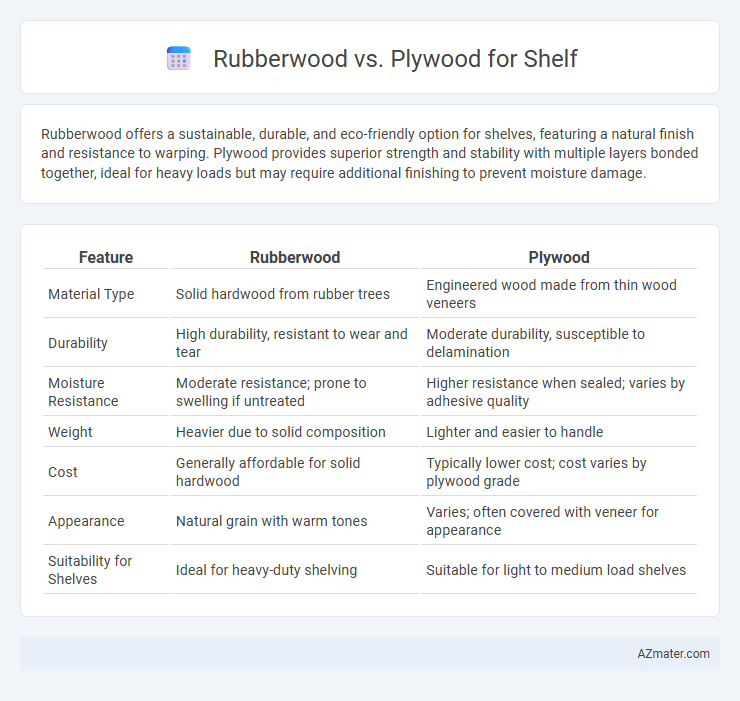Rubberwood offers a sustainable, durable, and eco-friendly option for shelves, featuring a natural finish and resistance to warping. Plywood provides superior strength and stability with multiple layers bonded together, ideal for heavy loads but may require additional finishing to prevent moisture damage.
Table of Comparison
| Feature | Rubberwood | Plywood |
|---|---|---|
| Material Type | Solid hardwood from rubber trees | Engineered wood made from thin wood veneers |
| Durability | High durability, resistant to wear and tear | Moderate durability, susceptible to delamination |
| Moisture Resistance | Moderate resistance; prone to swelling if untreated | Higher resistance when sealed; varies by adhesive quality |
| Weight | Heavier due to solid composition | Lighter and easier to handle |
| Cost | Generally affordable for solid hardwood | Typically lower cost; cost varies by plywood grade |
| Appearance | Natural grain with warm tones | Varies; often covered with veneer for appearance |
| Suitability for Shelves | Ideal for heavy-duty shelving | Suitable for light to medium load shelves |
Introduction: Rubberwood vs Plywood for Shelves
Rubberwood offers a dense, durable option for shelves, prized for its natural grain and eco-friendliness as a byproduct of latex production. Plywood provides strength and stability through its layered construction, resisting warping and offering versatility in thickness and finish. Choosing between rubberwood and plywood depends on the desired shelf appearance, load capacity, and environmental considerations.
Material Overview: What is Rubberwood?
Rubberwood is a sustainable hardwood derived from the Para rubber tree (Hevea brasiliensis) primarily after it stops producing latex. Known for its fine grain, durability, and resistance to warping, rubberwood offers an eco-friendly alternative to traditional hardwoods in shelf construction. Its dense structure and smooth finish make it ideal for both functional and decorative shelving applications, providing strength comparable to plywood but with a more natural wood aesthetic.
Material Overview: What is Plywood?
Plywood is a manufactured wood product made by gluing together thin layers of wood veneer, each with the grain oriented perpendicular to adjacent layers to enhance strength and stability. It offers superior resistance to warping and bending compared to solid wood, making it ideal for shelves that need to support heavy loads. The cross-grain construction of plywood provides durability and moisture resistance, distinguishing it from natural wood options like rubberwood.
Strength and Durability Comparison
Rubberwood offers excellent strength and durability due to its dense grain structure, making it highly resistant to warping and cracking under load. Plywood, constructed from multiple layers of wood veneers, provides superior dimensional stability and resistance to bending, enhancing shelf longevity under varying weight conditions. While rubberwood excels in solid wood strength, plywood's cross-layered design ensures better durability in moisture-prone environments, making the choice dependent on specific shelf usage and exposure.
Appearance and Aesthetic Qualities
Rubberwood offers a smooth, light-colored surface with a natural grain that enhances the warmth and rustic charm of shelves, making it ideal for contemporary and casual interiors. Plywood provides versatility in appearance, available in various veneers such as oak, birch, or maple, allowing for a customizable aesthetic that can suit both modern and traditional designs. While rubberwood maintains a consistent, uniform look, plywood's layered texture can add subtle visual interest and depth to shelving units.
Cost and Affordability
Rubberwood offers a cost-effective option for shelving, typically priced lower than high-quality plywood due to its abundant availability and faster growth cycle. Plywood, while often more expensive, provides superior durability and resistance to warping, which can justify the higher initial investment for long-term use. Balancing budget constraints with shelf longevity is essential when deciding between the affordability of rubberwood and the enhanced strength of plywood.
Workability and Ease of Installation
Rubberwood offers superior workability for shelves due to its consistent grain and smooth finish, allowing for easy cutting, sanding, and drilling without splintering. Plywood provides ease of installation with its lightweight and dimensional stability, reducing the risk of warping during assembly. Both materials support straightforward fastening methods, but rubberwood's solid surface often yields a more durable and polished final product.
Environmental Impact and Sustainability
Rubberwood, sourced from mature rubber trees no longer producing latex, offers a sustainable option by repurposing plantation timber and reducing deforestation, while plywood production often involves high energy consumption and formaldehyde-based adhesives that can harm indoor air quality. Rubberwood is biodegradable and involves fewer toxic chemicals, whereas plywood's layered construction may contain synthetic resins with potential environmental and health concerns. Choosing rubberwood shelves supports sustainable forestry practices and minimizes ecological footprints compared to traditional plywood alternatives.
Suitability for Different Shelf Types
Rubberwood offers excellent durability and a smooth finish, making it highly suitable for decorative or display shelves where aesthetics and moderate weight support are essential. Plywood provides superior strength and resistance to warping, ideal for heavy-duty or utility shelves that require higher load-bearing capacity and dimensional stability. Choosing between rubberwood and plywood depends on the shelf's intended use, with rubberwood favored for lightweight, attractive shelving and plywood preferred for robust, functional storage solutions.
Conclusion: Which is Best for Your Shelf Needs?
Rubberwood offers strong durability, eco-friendliness, and a smooth finish, making it ideal for shelves that require a natural, sturdy look. Plywood provides superior resistance to warping and moisture, offering versatility and cost-effectiveness for heavy-duty or functional shelving. Choose rubberwood for aesthetic appeal and environmental benefits, or plywood for strength and moisture resilience based on your specific shelf needs.

Infographic: Rubberwood vs Plywood for Shelf
 azmater.com
azmater.com